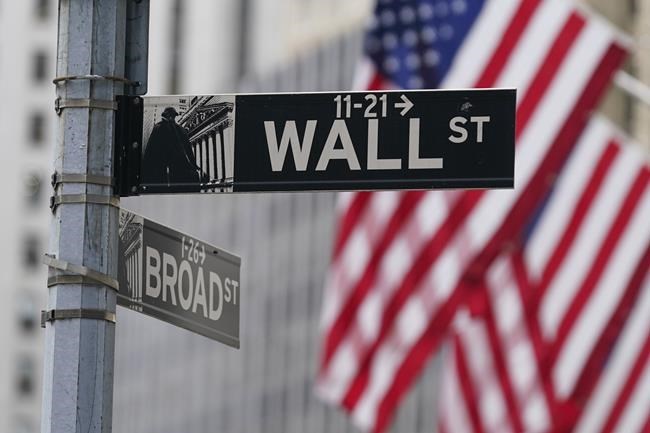NEW YORK (AP) — Wall Street drifted to a mixed finish as it closed out its 10th winning week in the last 11. The S&P 500 ended Friday up 0.1% and remains within 0.3% of its record after earnings season kicked off with mixed results from Delta Air Lines and others. The Dow fell 0.3%, dragged down by UnitedHealth Group. The Nasdaq was little changed. Bond yields sank after a report showed inflation at the U.S. wholesale level was weaker than expected. That bolstered expectations for upcoming cuts to rates by the Federal Reserve. Crude oil rose on worries about potential disruptions to supplies.
THIS IS A BREAKING NEWS UPDATE. AP’s earlier story follows below.
NEW YORK (AP) — Stocks are drifting near record heights in a busy Friday on Wall Street where oil prices were rising and bond yields were easing.
The S&P 500 was 0.1% higher in afternoon trading and within 0.2% of its all-time high set two years ago, as earnings reporting season kicked off with mixed results from Delta Air Lines, JPMorgan Chase and Wells Fargo.
The Dow Jones Industrial Average was down 100 points, or 0.3%, as of 2:30 p.m. Eastern time, and the Nasdaq composite was 0.1% higher.
In the bond market, yields sank after a report showed inflation at the U.S. wholesale level was weaker last month than economists expected. That followed a report from the prior day that had shown inflation at the consumer level was warmer than expected.
Friday's update gave Wall Street comfort and bolstered confidence that inflation is cooling enough for the Federal Reserve to cut interest rates several times this year. Rate cuts relax the pressure on the economy and financial system, while boosting prices for investments. And Treasury yields have already sunk since autumn on expectations for coming cuts to rates.
The yield on the 10-year Treasury eased to 3.95% from nearly 4% just before the report’s release. When it was above 5% in October, it was at its highest level since 2007 and putting sharp downward pressure on the stock market.
The two-year Treasury yield, which more closely tracks expectations for the Fed, fell to 4.16% from 4.27% before the wholesale inflation report’s release. Traders rebuilt bets that the Federal Reserve will begin cutting interest rates in March, according to data from CME Group.
Traders are largely betting on the Fed cutting its main interest rate at least six times through 2024. That would be a much more aggressive track than the Fed itself has hinted. Fed officials have even cautioned they may raise rates further if inflation refuses to buckle convincingly toward their target of 2%. The federal funds rate is already at its highest level since 2001.
“The danger of Fed fine-tuning is that they could be fiddling while the economy is burning down,” said Brian Jacobsen, chief economist at Annex Wealth Management. “If they’re data-dependent, that means they’re looking in the rearview mirror. Now they need to shift their gaze forward through the windshield.”
Interest rates are one of the main levers that set where stock prices are. The other is how much profit companies are making, and analysts expect the S&P 500 to deliver a second straight quarter of growth after earlier faltering under the weight of high inflation.
The reporting season for the end of 2023 unofficially got underway Friday with a bevy of reports from banks.
Bank of America slipped 0.5% after its profit for the last three months of 2023 fell short of analysts' estimates. Wells Fargo lost 3% after essentially matching analysts' expectations, while JPMorgan Chase was close to flat after reporting weaker results than expected.
UnitedHealth Group fell 3.6% despite topping analysts' profit forecasts. Medical costs for the health care giant soared, worrying investors.
Delta Air Lines sank 8.2% even though it reported stronger profit and revenue for the final three months of 2023 than analysts had forecast. The carrier gave a forecasted range indicating its upcoming full-year profit could be below what analysts had been expecting.
The airline and other travel-related companies were also hurt by a rise in oil prices, which puts pressure on their fuel costs. United Airlines fell 9.9%, and Norwegian Cruise Line Holdings lost 4.1%.
Crude prices climbed on worries about potential disruptions to supplies after Yemen’s Houthi rebels vowed fierce retaliation for U.S. and U.K. strikes against them. A barrel of benchmark U.S. oil was up 0.9%. Brent crude, the international standard, rose 1.5%.
That helped stocks of energy companies to lead the S&P 500 with an overall gain of 0.9%. Valero Energy rose 2.2%, and Marathon Oil climbed 1.9%.
In stock markets abroad, Japan's Nikkei 225 jumped 1.5% to cap a week of strong gains that took it to levels unseen since 1990, when the country's bubble economy was beginning to deflate. Indexes were lower in much of the rest of Asia but higher across Europe.
___
AP Business Writers Matt Ott and Elaine Kurtenbach contributed.
Stan Choe, The Associated Press



